How does philanthropy vary across, and connect, the greater Charlotte region?
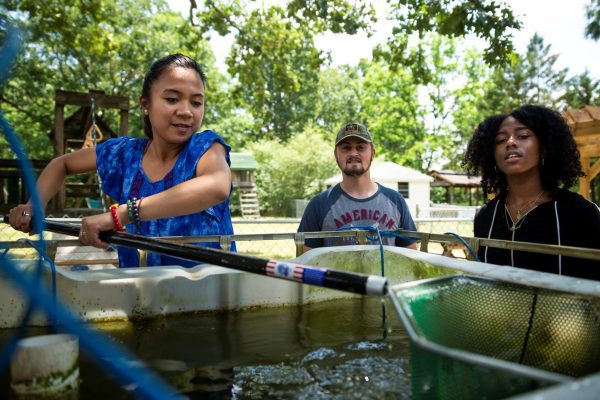
Charitable giving is an invisible thread binding people and communities together across the 32-county Carolinas Urban-Rural Connection study region — but how much people give, and what resources are available, varies from place to place.
The Carolinas Urban-Rural ConnectionA special project from the UNC Charlotte Urban Institute |
|---|
Giving to charity is one of the most common ways to help people in distress, support a cause or meet an immediate need. The amount of charitable giving in a community is often used as an indicator of civic engagement and well-being. Some commentators make a distinction between charitable giving, which helps to reduce or eliminate immediate suffering caused by social problems, and philanthropy, which assembles charitable and other funding sources and focuses them on the long-term elimination of those problems.
Both charitable giving and philanthropy are important to community and economic development in any given state or region. They fill the gaps where government and corporations cannot, they show strategies that can work to tackle important issues, and they provide support for the multitude of nonprofits that are the lifeblood of any community.
The Carolinas Urban-Rural Connection project sought to learn more about charitable giving and philanthropy in the region. How important is such giving? Are philanthropic funds concentrated in Charlotte and Mecklenburg County, or distributed more equally across the region? And can charitable giving and philanthropy be a way of connecting urban and rural communities?
[Read more: Community foundations demonstrate the importance of regional links]
Here are four things we learned by analyzing the data:
How much is given to charity in the region?
On average, households in the 32-county Carolinas Urban-Rural Connection region give almost $3,200 to charity every year. That adds up to a regional total of $4.6 billion. If grants and donations from foundations, bequests, and corporations are included, the amount rises to $6.75 billion. This is a significant contribution – for comparison, the City of Charlotte’s budget for 2019 is $2.6 billion.
A recent report on philanthropy for the year 2018 estimated that money given for charitable purposes in the U.S. totaled almost $428 billion: $292 billion was given by individuals and households, $76 billion by foundations, $40 billion through bequests, and $20 billion by corporations.
Sources of Philanthropic Giving, U.S., 2018

- Source: IUPUI Lilly Family School of Philanthropy (2019). Annual Report on Philanthropy for the Year 2018: Key Findings. Giving USA.
Although the most reliable data on individual and household charitable giving comes from the Internal Revenue Service, this is limited to the 10 percent of taxpayers who itemize their deductions. The Urban-Brookings Tax Policy Center estimates that itemized charitable giving accounts for 60 percent of individual giving, with the remaining 90 percent of non-itemizing households contributing the remainder.
The latest available IRS data on itemized charitable giving at the county level is from 2016. For the 32-county study region, the itemized total was over $2.7 billion. Assuming this represents 60 percent of total individual and household charitable giving, the region’s households gave approximately $4.6 billion to charity in 2016 – equivalent to $3,194 per household.
- Sources: Urban Institute & Brookings Institution Tax Policy Center. Tax Policy Center Briefing Book: Key Elements of the U.S. Tax System. https://taxpolicycenter.org; Internal Revenue Service. North Carolina: Individual Tax Returns: Selected Income and Tax Items by State, County, and Size of Adjusted Gross Income, Tax Year 2016.
Does giving to charity vary across the region?
As might be expected, 40 percent of household charitable giving in the region comes from Mecklenburg County. However, estimating household giving as a proportion of household income shows a more even distribution of generosity across the region.
The first map shows how total estimated household charitable contributions by county are distributed across the region: $1.8 billion (39.5 percent) comes from Mecklenburg County, with over $1.3 billion from the five next-most populous counties of Union, York, Cabarrus, Iredell, and Gaston. The second map shows estimated household charitable contributions as a proportion of total household income by county across the region.
The highest proportions are to be found in Polk (5.1 percent) and Davie Counties (4.6 percent), with ten counties, including Mecklenburg, in the range of 4.1 to 4.5 percent. The regional average is 4.2 percent.
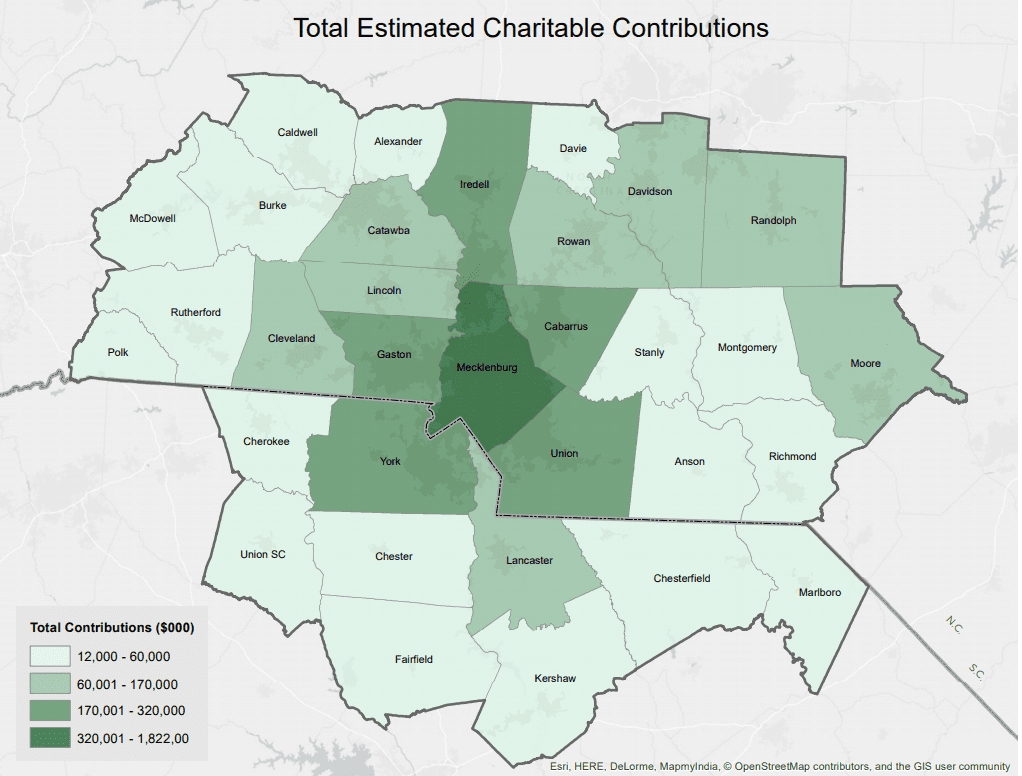
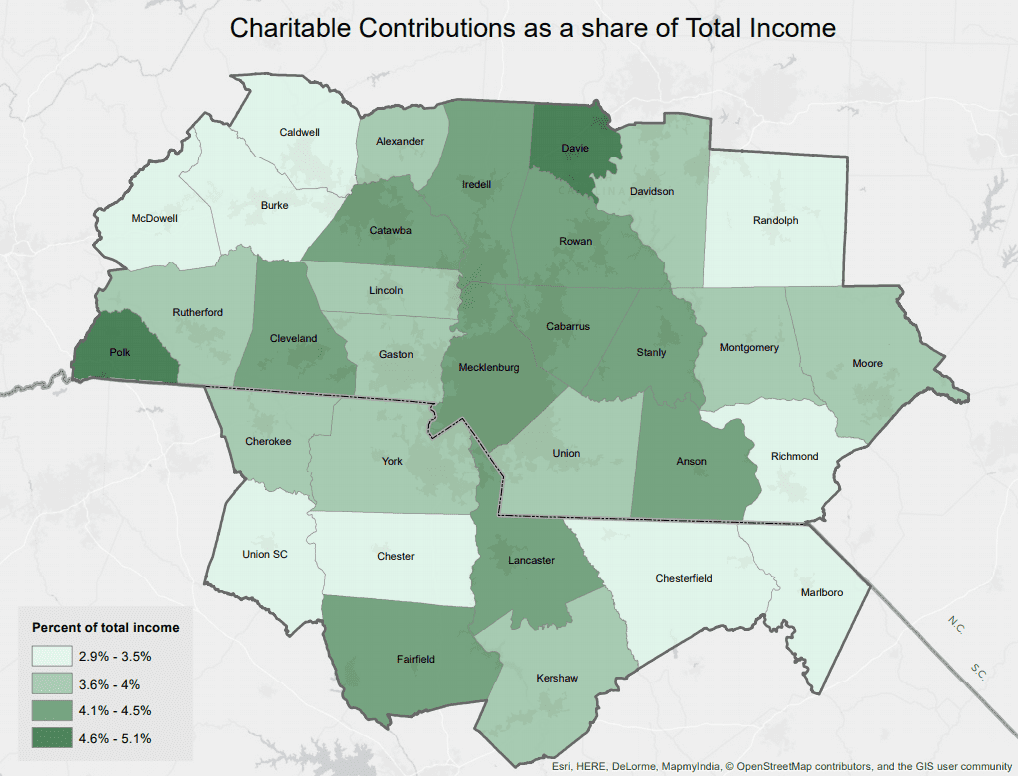
- Sources: Urban Institute & Brookings Institution Tax Policy Center. Tax Policy Center Briefing Book: Key Elements of the U.S. Tax System. Internal Revenue Service. North Carolina: Individual Tax Returns: Selected Income and Tax Items by State, County, and Size of Adjusted Gross Income, Tax Year 2016.
What is this charitable giving used for?
Nationwide, about one-third is donated for religious purposes, with just over another third directed to education, human services, and foundations.
Of the $428 billion donated for charitable purposes in 2018, 29 percent (almost $125 billion) was directed to religious organizations, with 14 percent to education ($59 billion), 12 percent to human services ($52 billion), and 12 percent ($50 billion) to grant-making foundations. Applying these proportions to the Carolinas Urban-Rural Connection region, this could mean almost $2 billion was directed to religious organizations from all sources.
No information is available on how this money is used by religious organizations at the national, state or local level. It can be assumed that most of these funds are used to cover the capital and recurring costs of running these institutions and support their work with their congregations. However, there is evidence to suggest that in urban centers, sacred places have significant economic impact through the employment of staff, purchases of goods and services, and the attraction of visitors for worship, events, education and welfare. A study of congregations in Chicago, Philadelphia, and Fort Worth showed that on average each sacred place generated $1.7 million in economic impact.
Parallel research is underway to look at rural sacred places and their impact (Note: The Urban Institute is currently working with Partners for Sacred Places on the rural study, funded by The Duke Endowment). Anecdotal information suggests that many are struggling for survival and that, in some cases, there is ongoing support coming from urban congregations to sustain their activities.
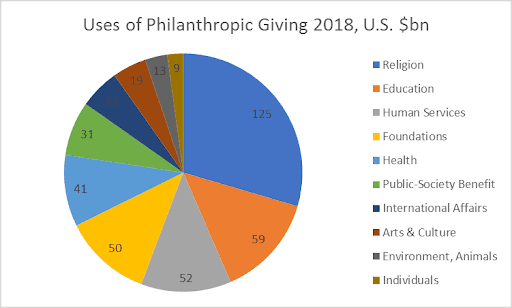
- Sources: IUPUI Lilly Family School of Philanthropy (2019). Annual Report on Philanthropy for the Year 2018: Key Findings. Giving USA.; Partnership for Sacred Places (2016), The Economic Halo Effect of Historic Sacred Places.
How much charitable giving is directed towards philanthropic activities in the region?
About 10 percent of individual giving in the United States, amounting to $29 billion, is directed to donor-advised funds, 15 percent of which are managed by community foundations. There are seven community foundations with a footprint in the Carolinas Urban-Rural Connection region.
There are 463,622 donor-advised fund accounts in the United States. These have total assets of $110 billion and make grants annually amounting to over $19 billion (2017). About 15 percent of them, or 70,215, are held at community foundations, which together have assets of $38.61 billion, receive annual contributions (2017) of $6.76 billion, and give $5.78 billion for charitable purposes.
The Council on Foundations describes community foundations as grantmaking public charities dedicated to improving the lives of people in a defined local geographic area, often a county. They bring together the financial resources of individuals, families, and businesses to support the work of nonprofits in their communities. Here are the seven community foundations that have a presence in the Carolinas Urban-Rural Connection region.
Community Foundations with a Carolinas Urban-Rural Connection Footprint

The Foundation for the Carolinas (FFTC), headquartered in Charlotte, is by far the largest. FFTC has 13 affiliates, all within the Carolinas Urban-Rural Connection region. The following table lists the affiliates, with the top three program investment areas for each.
Foundation for the Carolinas Affiliate Community Foundations
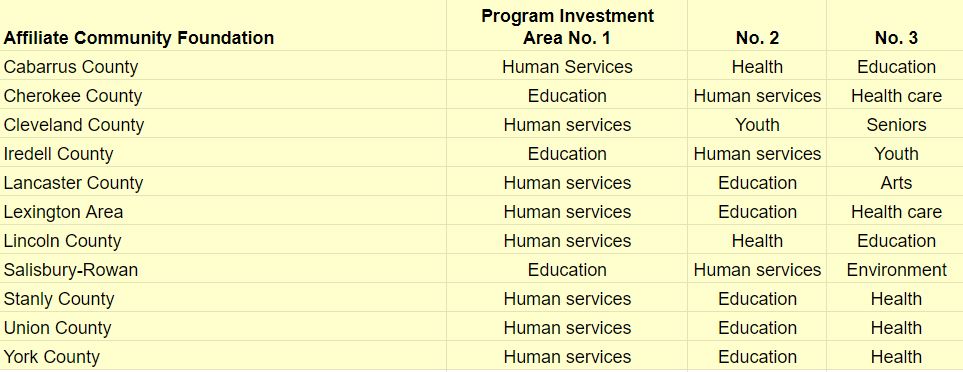
Program investment data for Foundation For the Carolinas affiliates, Charlotte-Mecklenburg Community Foundation and The Cole Foundation (Richmond County), is calculated differently and is therefore not included with this table.
- Sources: National Philanthropic Trust (2018), 2018 Donor-Advised Fund Report; North Carolina Rural Center, IRS Form 990, 2017; Foundation for the Carolinas
[Read more: Community foundations demonstrate the importance of regional links]
Brian Dabson